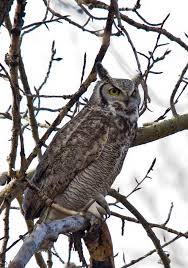 The great horned owl is one of Ontario’s most common owl species, and the largest (in overall size). Seeing the Great Horned Owl in and around Wawang Lake is very common but you will need to keep a keen eye open for them as they are camoflaged so well into their surroundings that they are hidden to the human eye.
The great horned owl is one of Ontario’s most common owl species, and the largest (in overall size). Seeing the Great Horned Owl in and around Wawang Lake is very common but you will need to keep a keen eye open for them as they are camoflaged so well into their surroundings that they are hidden to the human eye.
This owl is quite distinct in size and features. It has large yellow eyes, and prominent ear tufts (horns). It has a broad face, curved beak, visible facial disk (darker feathers around face) and large talons. The great horned owl is a brown-grey, with distinct barred underparts and their markings help them camouflage (blend) in trees. Females, as with all raptor species, are significantly larger than males. This is a nocturnal owl, meaning it is most active at night. This owl makes a booming call, whoo-hoo-ho-o-o. Also, this bird DOES NOT migrate.
Habitat:
Great horned owls are found in a variety of habitats. They prefer to live in open woodlands, with secondary-growth forests or around agricultural areas. They are commonly found in boreal forests, or mixed forests with both deciduous (leafy) and coniferous (needle) trees.
 Breeding:
Breeding:
The great horned owl does not make their own nests; instead they find nests from other animals to use. Nests are usually only used for a single mating season because they are easily destroyed by all the hatchling activity. These owls will take nests from red-tailed hawks, crows, and even squirrels. This owl may also nest in tree cavities, or rock ledges.
This species is territorial, and on average there will be one pair per 7-10 km2. Great horned owls will pair with a single mate for their life, unless that mate is killed, and will return to the same territory for a number of years. This owl will not breed until their second year, although occasionally younger birds breed if food is abundant.
Great horned owls breed during the winter months (January-February). The eggs are incubated by the female for one month. Females will lay 1-5 eggs with food availability being the biggest factor that affects the number of eggs deposited. Hatchlings appear mid-April to early May, and the mother will brood (sit on young and keep safe and warm) the hatchlings continuously for 2 weeks, with the male being responsible for bringing food to the mother and hatchlings. Owlettes (baby owls) are covered in down feathers (fluffy) and will not be able to leave the nest until 2 months of age. The young will remain within their parent’s territory until the fall.
Time before fledging, the period of first flight, is critical for the owlettes to learn how to hunt, fly, and be an owl (if owlettes are raised by humans during this time, they will be human-imprinted, meaning they will think they are a human as they aren’t born knowing they are owls…they imprint on the first thing they see-which would be their own parents). Death rates are high, with 50% of young that leave the nest dieing during their first year.
 Diet:
Diet:
Great horned owls are a top predator and are strictly carnivorous. They eat different sized prey, ranging from the size of a mouse to as large as a goose. One of the great horned owls favourite meals is skunk, and they are the only natural predator to skunks-they don’t have a sense of smell, so skunks have no defenses against this owl. Small prey, such as mice, are swallowed whole, while larger prey are dismembered before eaten. Owls eat ALL their prey; however, not all is digestible. Fur, feathers, teeth and bones are not digested and are compacted into a pellet which the owl will regurgitate before their next meal.
Threats to species:
The biggest threat to the great horned owl is humans. They are commonly hit by cars, due to their nocturnal hunting, collide with buildings, fly into power lines, and are shot by farmers.
Threat to humans:
This owl is really no threat to humans. They will aggressively protect their nests, so don’t bother them during nesting season, but otherwise, if you see one count yourself lucky.
Fun facts:
- The great horned owl will hang large prey in trees and will eat it for a number of days.
- Crows regularly harass great horned owls, so if you see a tree with a ton of crows flying into it, there is most likely a great horned owl there.
- Great horned owls will eat porcupines, and commonly have porcupine quills stuck to their body.
Follow our HUNTING BLOG
WEB RATES FISH HUNT CABINS PHOTOS
TESTIMONIALS BROCHURE HUNT BOOKLET

